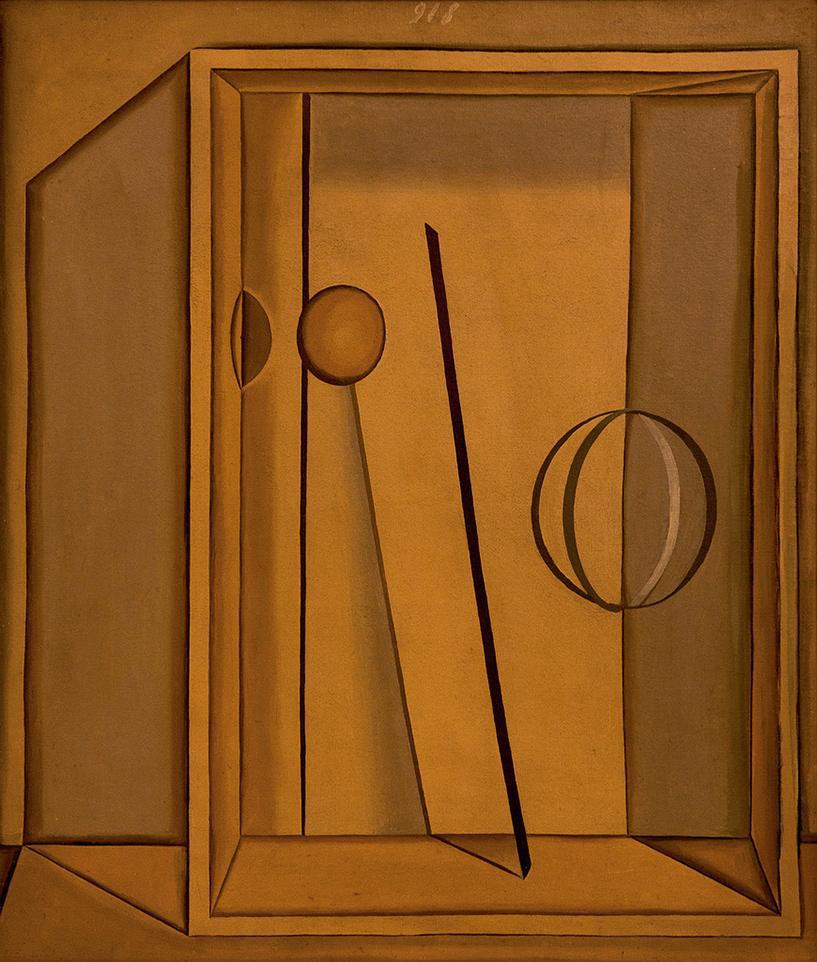Giorgio Morandi was born in Bologna on 20 July 1890. He lived along his mother and sisters, all of whom were close together. Displaying his artistic talent from a young age, Giorgio surfaced in the city’s popular discourse during his adult life.
Being an introvert, Giorgio walked his own artistic path outside the artistic movements and societies of his time. His knack for painting bottles, glasses and other ceramics, amounted to a strong composition skillset but was occasionally met with disdain. He passed away bedridden on 18 June of 1964.
Starting on 1909 Morandi studied in Accademia di Belle Arti as a pre-university student and later continued as a regular student. During the last two years of his studies, he created his own artistic universe that was not particularly well received by his professors. The Morandi’s universe had its own dedicated language, showing influences from Cezane, Rousseau, Derain, and Picasso.
In 1913, Morandi started painting landscapes (paessaggi) in Grizzana, a village close to Bolognia. Later the village was named Grizzana Mornadi in honor of the artist’s contribution to local culture. During that period, Morandi developed an interest for futuristic ideas and poetry, due to his contact with Osvaldo Licini. He also became familiar with Marinetti’s and Russolo’s futurist approach to art.
In a time that everything alternative was considered futuristic, Morandi organized an exhibition together with Osvaldo Licini, Mario Bacchelli, Giacomo Vespignani and Severo Pozzati. That exhibition was considered as part of the futurist movement, although Morandi himself never acknowledged any affiliation with that movement, or any other. He experimented with both futurism and cubism. Influences of the latter can be seen in his bottle arrangements, but as with the futurist movement, he never claimed to be a cubist.
In general, Morandi’s artistic approach is summed up as detailed and obsessive repetition, on which he achieved a high level of expertise. Attempting to categorize his artistic tendencies would place him on the so called Metaphysical Artistic movement. This classification can be supported by a series of paintings in the collection Metaphysical Still Life (im. 1,2,3). It is in these those works that the art critic can recognize Morandi’s profound study of Giorgio De Chirico.

Im. 1 Morandi Giorgio, Metaphysical Still Life, Italy, 1918, oil on canvas.

Im.2 Morandi Giorgio, Metaphysical Still Life, Italy, 1918, oil on canvas, 71,5×61,5 cm Hermitage Musem, Russia.

Im.3 Morandi Giorgio, Metaphysical Still Life, Italy, 1918, oil on canvas.
Morandi was painter and engraver. Starting with his landscape works (im.4,5) displaying Grizzana and Bologna and his love for nature, he placed great importance on the lighting. Between natural colors and shadows, it can be observed that he did not follow the traditional process to capture reality. Instead, he adopted a number of photography elements and focused on the secondary details. As can be seen on the following image, Morandi framed the painting using a particular angle and distance from the object, resembling the zoom function of a photographic camera, in order to paint a specific part of the view.

Im. 4 Giorgio Morandi, Landscape (Further details unavailable).

Im.5 Morandi Giorgio, Morandi a Ragghianti 1942, Italy, 46,5×53,4 cm, olio su tela, Palazzo Pitti, Florence, Italy.
The natura morta phase that made Morandi’s artistic universe famous around the world comes after his landscape phase and after De Chirico’s influence on his work. Morandi concentrated on building scenes with bottles on a table. He worked isolated in his studio, a room with a view on the yard of the house that was living with his three sisters. Morandi had a habit of collecting bottles and vases from the restaurants and the streets around the city. His natura morta was particularly prolific in bottle imagery with the occasional display of a single flower (im. 6,7,8).

Im. 6 Natura Morta, Museo Morandi, Bologna, Italy.

Im. 7 Im. 7 Natura Morta, Museo Morandi, Bologna, Italy.

Im. 8 Morandi Giorgio, Fiori, 1948, Italy, 40.0 x 30.0 (cm), oil on canvas, Galleria d’Arte Maggiore G.A.M., Turin, Italy.
Is it true that Morandi obsessionally painted repeatedly the same thing? Is it true that the paintings of Morandi are all the same? Morandi’s natura morta are objects like bottles, vases, jugs, glasses, even boxes, sometimes on a table, however all the paintings of Morandi have their own characteristics and are different: object placement, visual angle, geometric composition, colouring and lighting, are all differentiating factors of Morandi’s work, although the subject is often constant. Morandi creates a theatrical scenography. Some of his his works create the impression that the bottles are in dialogue between them, while others seem to propose a dialogue with the viewer. It could be surmised that every bottle, vase, and box on Morandi’s works represents a person. Similarly, the chosen arrangements echo social relations, displaying unity or disorganization.
Above all, Morandi mastered his technique, developed his methodology by repetition, projecting serenity, intimacy, security, and personal enjoyment. His own life through his artistic process became a paradigm of personal development. It appears like a flower in vase.
Sitografia
https://giorgiomorandi.it/biografia-giorgio-morandi/ (07/02/2022)
https://www.christies.com/features/Giorgio-Morandi-guide-10098-3.aspx (07/02/2022)
https://www.hermitagemuseum.org/wps/portal/hermitage/digital-collection/01.%20paintings/29393/!ut/p/z1/04_Sj9CPykssy0xPLMnMz0vMAfIjo8zi_R0dzQyNnQ28_J1NXQwc_YMCTIOc_dwNDE30w8EKDHAARwP9KGL041EQhd94L0IWAH1gVOTr7JuuH1WQWJKhm5mXlq8fYWCop1CQmJlXkpmXXqwfYWRpbGkMdEsUmmme3uZA00JMPfz9w5yNnE2gCvC4pyA3NKLKx8Mg01FREQABSXEP/dz/d5/L2dBISEvZ0FBIS9nQSEh/?lng=en (07/02/2022)
https://moonchoistudio.com/blogs/journal/giorgio-morandi-metaphysical-still-life (07/02/2022)
https://www.uffizi.it/opere/paesaggio-morandi (07/02/2022)
https://www.artesplorando.it/2016/02/giorgio-morandi-vita-e-opere.html (07/02/2022)
https://artintasca.wordpress.com/2014/02/24/casa-museo-di-giorgio-morandi-bologna/ (07/02/2022)
https://www.artbasel.com/catalog/artwork/44829/Giorgio-Morandi-Fiori-Flowers (07/02/2022)
https://lucamaggio.wordpress.com/2010/10/05/giorgio-morandi-l%E2%80%99arte-di-annullare-il-tempo/ (07/02/2022)
https://www.britannica.com/art/Japanese-art (07/02/2022)

